Tantuni is a delightful blend of tiny sliced beef (or other meat) combined with onions, tomatoes and spices, wrapped in a delicious lavash bread.
This specialty has become a staple of Turkish street food culture, and its unique blend of flavors and textures has carried the tempting dish to many loyal followers around the world,
Let’s invite you to a journey of taste and inspiration where the Mediterranean meets the Turkish cuisine in a perfect and easy-to-make dish. Learn how to make tantuni wraps to enjoy the magical smell and the captivating joy of Middle Eastern cuisine right at home.
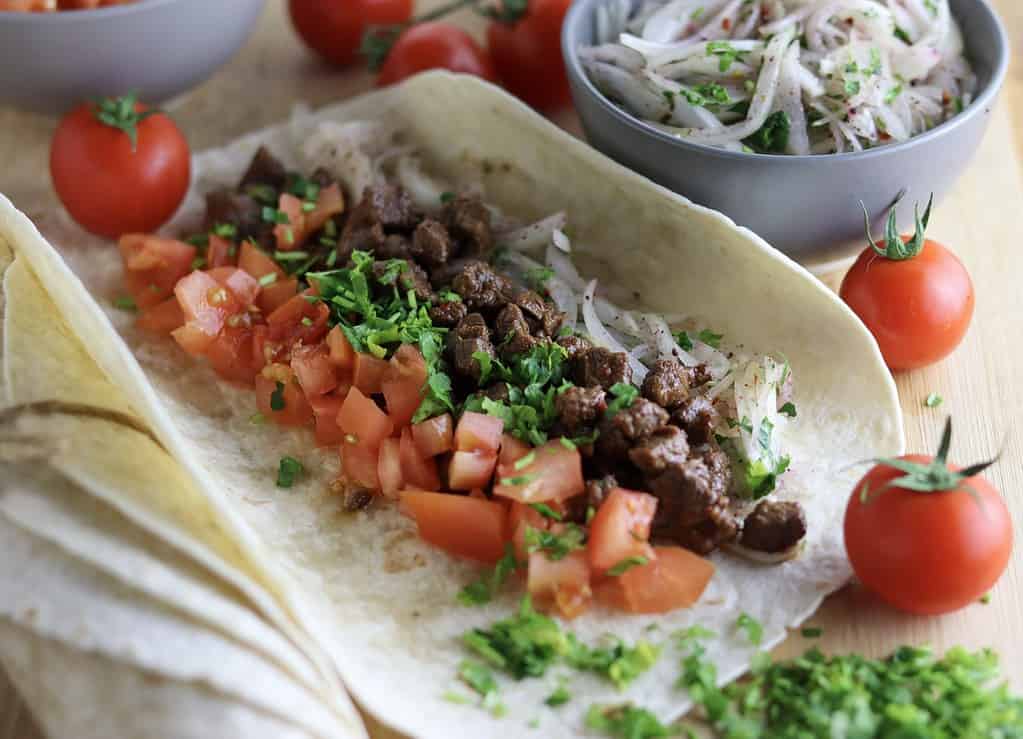
Tantuni, a delicious taste of Turkish street food
Tantuni is a popular Turkish street food originating in southern Turkey. While menemen (or sataras) shines as a delicious, thrifty Turkish breakfast and taboule as a worldwide famous salad, tantuni is a perfect, widely available street meal. Besides the authentic beef goulash, kljukuša and ricet, tantuni is our favorite Euro-Asian dish.
Tantuni is usually made of sliced beef or lamb, sauteed in a delightful sauce with spices, such as paprika, chili flakes, and sumac. The meat is typically cooked on a hot griddle and wrapped in a thin lavash or pita bread with fresh tomatoes, onions, parsley, and a squeeze of lemon juice.
The resulting wrap is a flavorful and satisfying meal that has become a beloved street food in Turkey and spread its wings worldwide.
A journey through tantuni’s origins
The home of tantuni is the city of Mersin, located in the south, on the Mediterranean coast. There are stories that the flavorful meal was named after the “tantuni eti” , a local cut of beef that is the main ingredient of tantuni.
According to a local anecdote, Tantuni was first created by a group of street vendors who were looking for a new and innovative way to serve grilled meat to people passing by. They began experimenting with different cuts of beef and spices, eventually settling on thinly sliced cubes of beef seasoned with a combination of sumac, salt, and pepper.
However, some other sources mention that the first tantunis were originally made from pieces of offal stir-fried in cottonseed oil.
Next, another local legend reveals a chef in early 1900 who decided to try making a new dish with the ingredients he had on hand. He fried slices of beef marinated in a blend of spices, wrapped it in a thin flatbread with onions, tomatoes, parsley, and a spicy sauce, and served it to hungry customers.
A fourth local story mentions a shepherd who decided to sell his beef and named it based on the sounds (tan tun) that his big spoon was making while touching a huge frying pan.
It’s quite obvious that the true origins of tantuni are a bit difficult to trace. The stories of tantuni seem to be many. Tantuni has probably evolved over time and has been influenced by various cultures and cuisines.
But regardless of its origins, the flavorful, delicious wrap remains a beloved Turkish street food dish enjoyed by crowds.
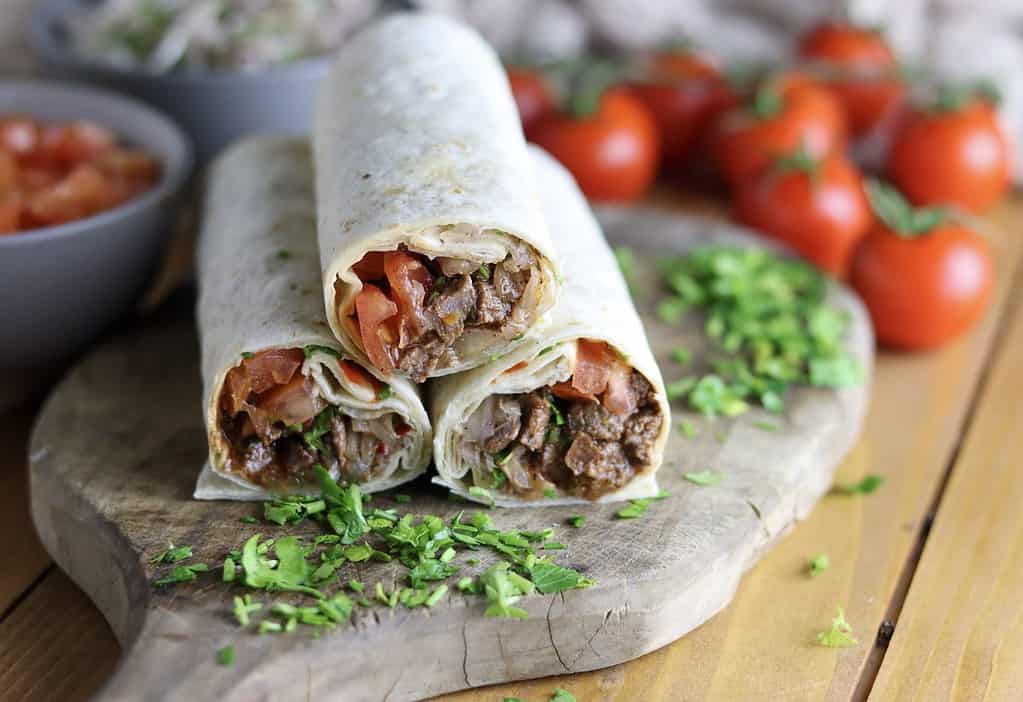
Pamper your inner foodie with the wonders of tantuni
Let’s name just a few reasons why you’ll love tantuni made by this recipe:
- The incredible taste. A combination of beef, sauce, onions, fresh vegetables and spices in a hot wrap will charm your taste buds like no other. The beautiful smells of the Mediterranean, perfectly combined with the flavors of the Middle East are somewhat addictive.
- It’s easy to make it; it requires no special abilities to prepare tantuni. If you use store-bought lavash bread or tortilla wraps, your dinner will be ready in less than an hour.
- You can prepare the meat with the sauce in advance. When reheated and fused with some fresh onions and tomatoes, you’ll make your delicious flatbread wraps again and again. You can really get creative and experiment with tantuni. This dish is one of those things you wouldn’t mind eating every day.
Ingredients combined in a tantuni wrap
BEEF – We used sliced beef stakes for this recipe. However, for tantuni you should use a cut of beef that’s tender and flavorful, such as flank steak, sirloin, or ribeye. These will soften quicker, and the fat contains in these are just ideal. If the beef has too much connective tissue, it can make the meat tough and chewy.
Slice the beef very thinly against the grain, preferably into small cubes. This will help to break down the muscle fibers and make the meat even more tender.
FAT OR OIL – The original tantuni used to be prepared with cottonseed oil. The one you find on the streets is usually very high in fat because of the added butter at the end of frying.
When preparing tantuni at home, you can use any fat or oil, like lamb fat, butter or olive oil. Tantuni in this recipe was made with organic olive oil, which turned out perfect. It’s definitely less greasy then the one on the street. If you want it to contain more grease, add more oil, fat or butter towards the end of cooking.
ONIONS – Traditionally, red onions are used to prepare the tantuni. These are less strong and have a milder and sweeter taste compared to yellow or white onions.
If you can’t find them, yellow and white onions will still be ok. They have a little stronger flavor, but when sliced thinly and mixed with the spices, they don’t turn out so strong.
TOMATOES – Try to use fresh and the most flavorful tomatoes you can get. Remember, keeping ripe tomatoes at low temperatures (like in the fridge) can significantly reduce their taste and flavor. Besides tomatoes, you can also add fresh red peppers to the sauce or as an addition to the wrap.
LAVASH BREAD OR TORTILLA WRAPS – Tantuni is best made with bigger and wider fresh homemade lavash bread. Not to worry, if you don’t have the time to make it (like us), buying premade flatbread or tortilla wraps will still work out well.
SALT AND BLACK PEPPER – Nothing more than salt, black pepper and a few spices need to be added to the beef to create the delicious taste of the beef gravy. FRESH PARSLEY is mixed with the onions and perfectly enhances the flavor of the wrap.
PAPRIKA AND CHILI FLAKES – With its sweet, smoky flavor and bright red color, paprika will subtly boost the aroma and add a visual appeal to tantuni sauce. And chili flakes will add a spicy kick.
SUMAC is a flavorful spice that is traditionally added to tantuni wraps. It’s made from the berries of Rhus Coriaria shrub that grows wild in the Mediterranean region, Western Asia and the Arabian peninsula.
Sumac adds a bright and refreshing note to the tantuni, bringing a citrusy flavor that is slightly sour and fruity, enriching the complexity of the flavor. Besides that, tannin polyphenol-rich sumac positively affects the meat’s oxidative stability and has an additional tenderizing effect.
Sumac spice can be found in many well-stocked supermarkets or stores with spices. However, it can be also substituted with ground coriander, lemon zest, lemon juice or vinegar.
How to make the perfect tantuni
PREPARE THE INGREDIENTS
STEP 1: Peel the onions and cut them into thin slices. Mix them together with fresh parsley, sumac and a tablespoon of oil. If you wish your onions to taste spicier, you can add some chili flakes to the bowl as well.
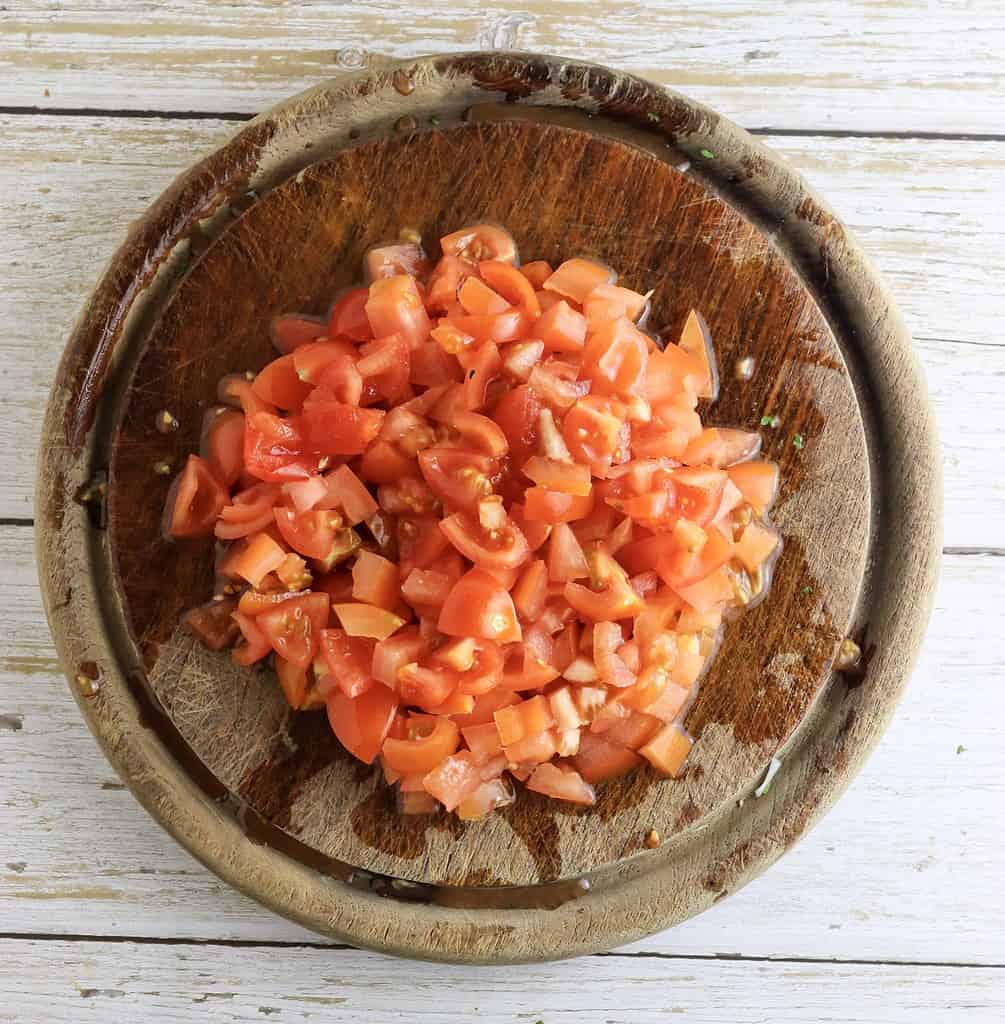
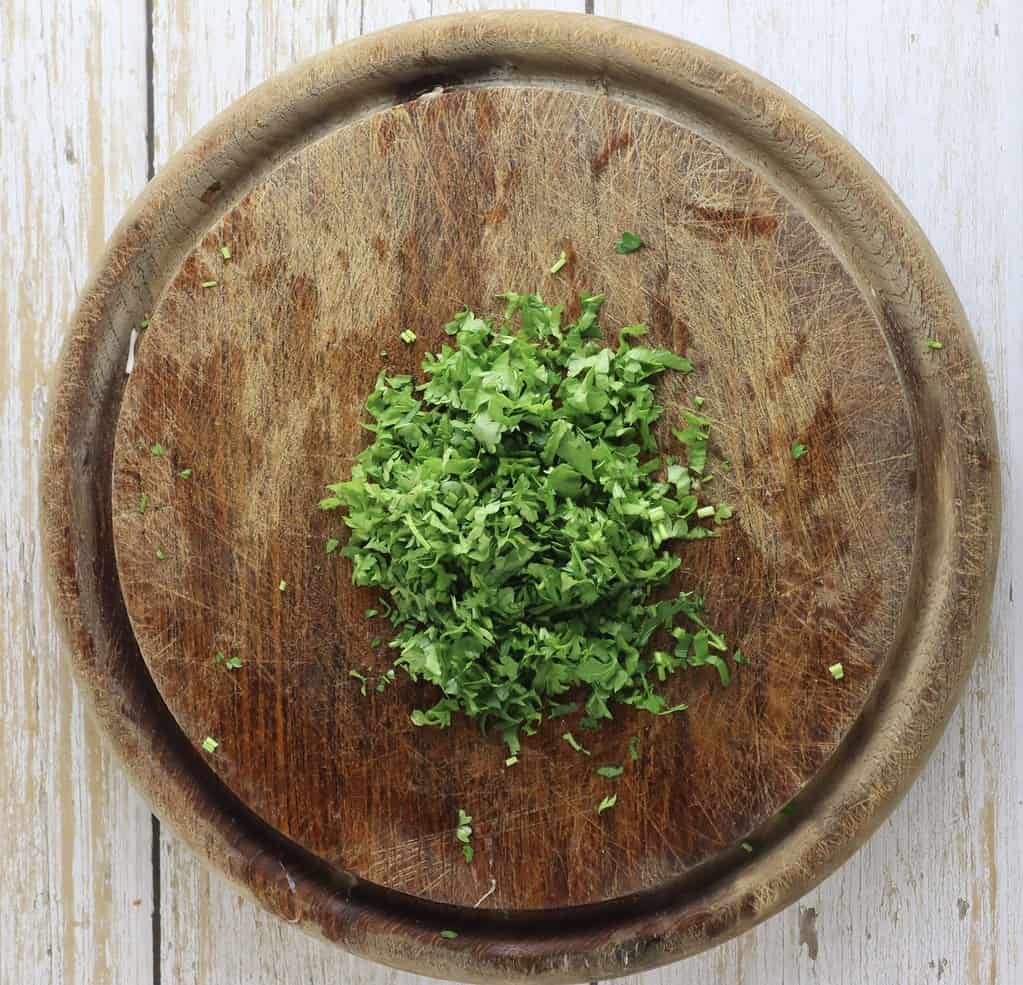


STEP 2: Cut the beef into small cubes or slices and prepare the tomatoes. Cutting against the grain will help to break down the muscle fibers and make the meat more tender.
Quickly stir-fry the beef in hot olive oil or fat and cook on low heat for about 20 minutes (or more) until the beef releases the liquid, softens, and the water evaporates. If needed, add more water. To exceed the tenderizing process, add salt, a tablespoon of vinegar or citrus juice.

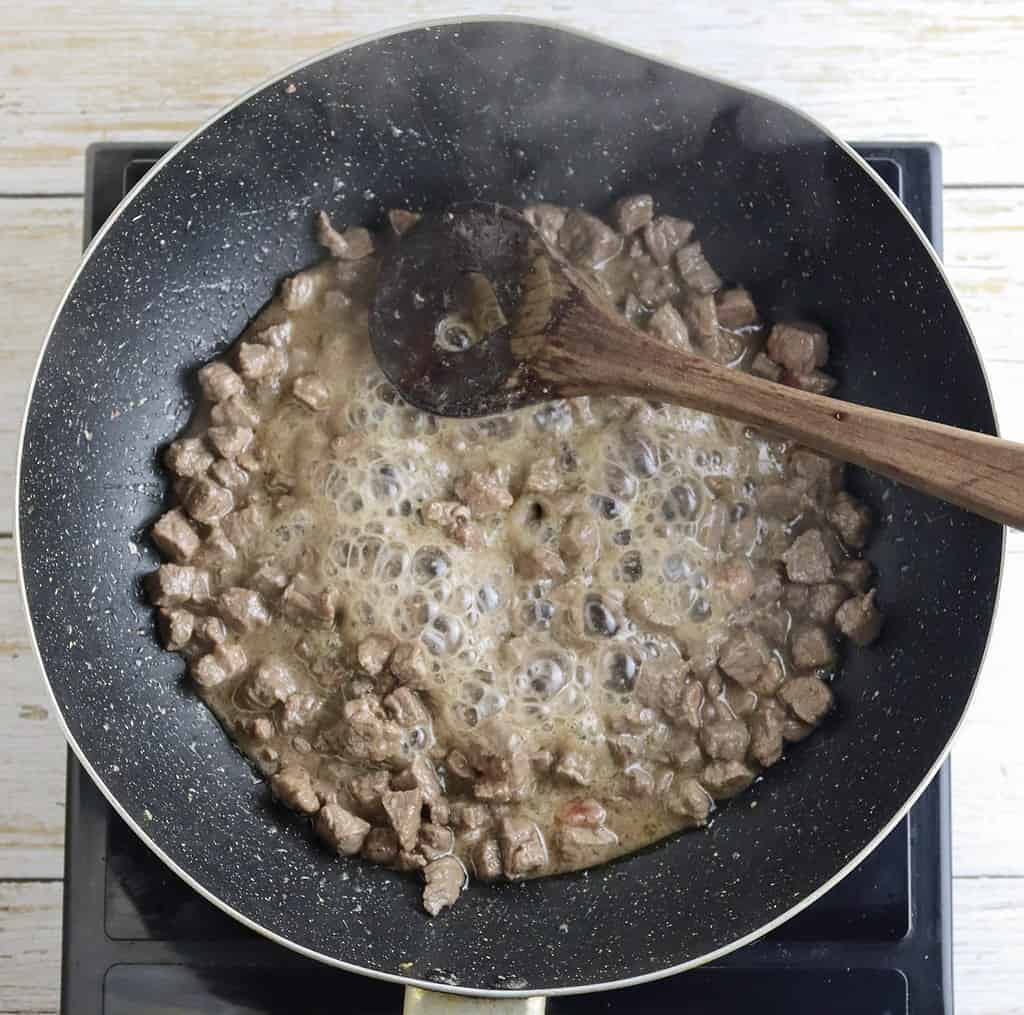
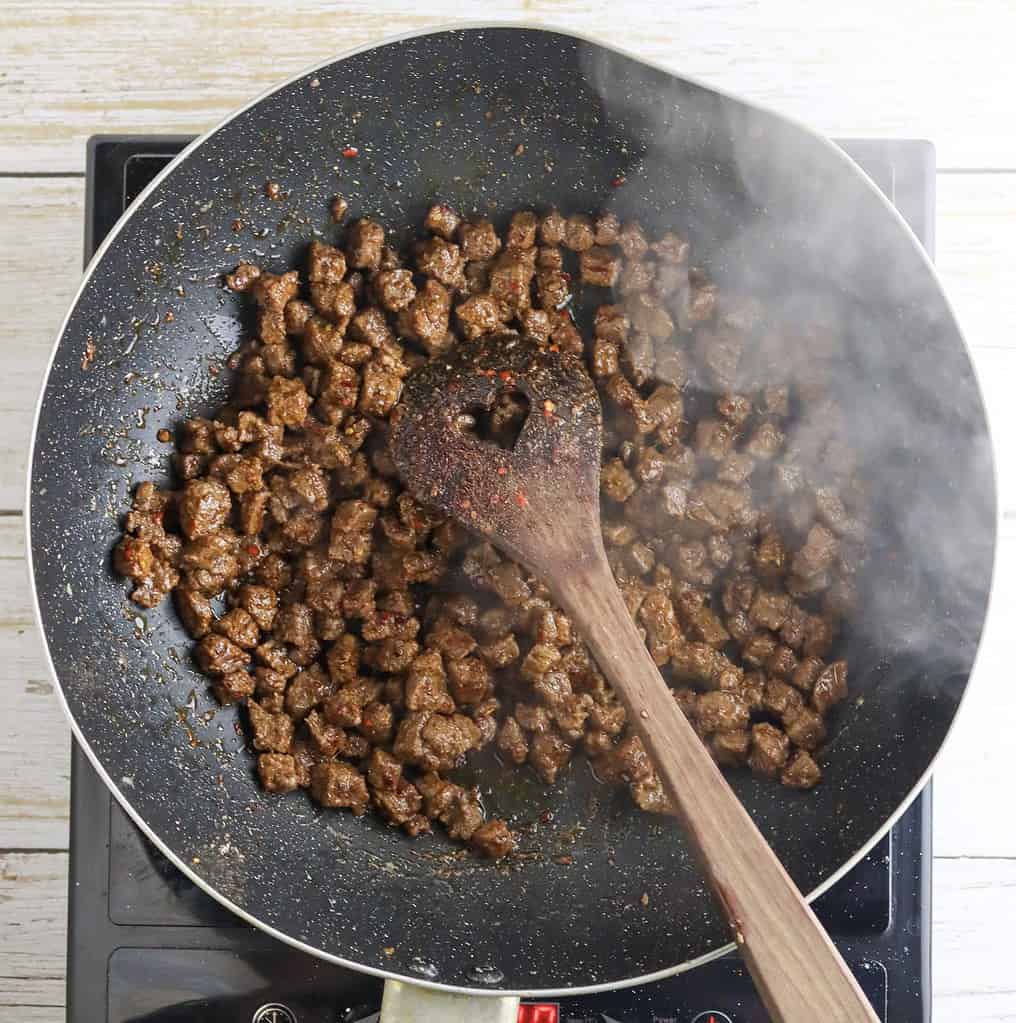
PREPARE THE BEEF GRAVY FOR TANTUNI
STEP 3: When tantuni beef is sold on the street, it’s usually slowly warmed the whole day on the sides of a tantuni pan with a curved spot in the center. That serves for the final heating and preparation of the gravy.
When making tantuni wraps at home, it’s therefore important to first follow the beef tenderizing process. Otherwise, the beef will turn out too sturdy.
After the beef is softened enough and the liquid has evaporated, add a little bit of fat or oil to the pan again, together with the spices (black pepper, sumac, chili flakes, and paprika). Quickly stir-fry for a minute.
STEP 4: Add a cup of water to the pan and stir well so that all ingredients combine. Cook on low heat for another 15 minutes.

STEP 5: When the liquid is almost gone, leaving you with an ideal and preferred amount of sauce, cover the beef in the pan with lavash bread or tortilla to heat up while covering the gravy. Heat it on one side only and leave the other side dry.

ASSEMBLE THE TANTUNI WRAPS
STEP 6: Top the warm flatbread or tortilla wrap with onions, tomatoes, beef and maybe a teaspoon of additional parsley. If you love the taste of sumac, you can add more.
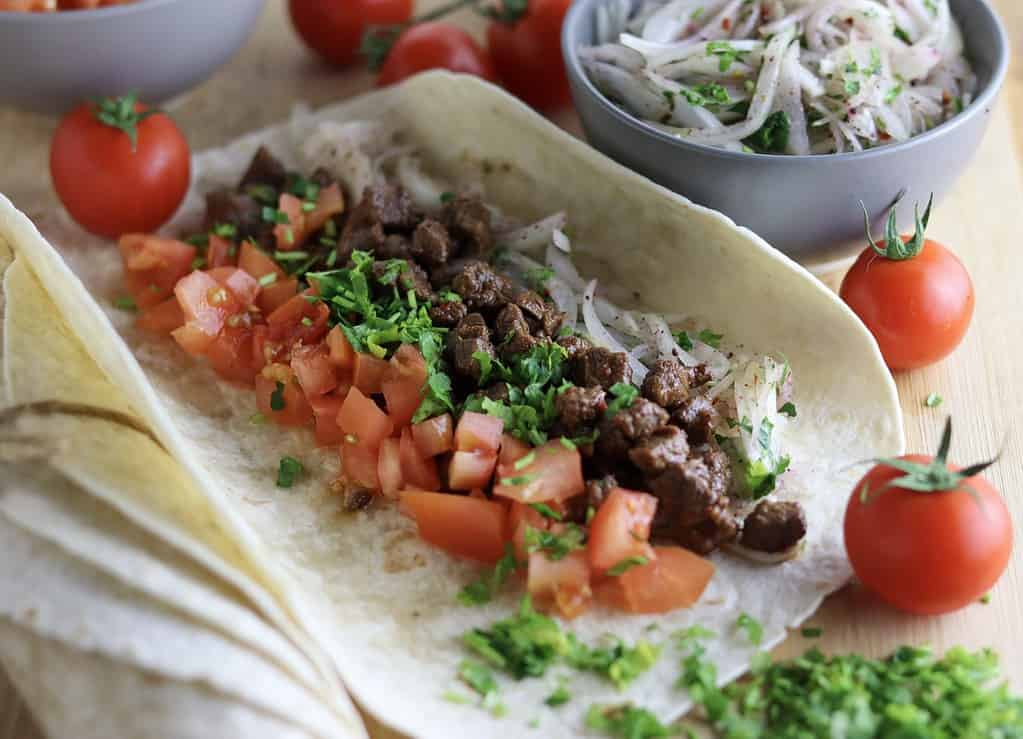
STEP 7: Wrap the lavash or tortillas as tight as you can and ensure the sides are closed to prevent the ingredients from leaking out. Continue the process with the rest of the bread as long as you have enough ingredients.
STEP 7: Serve hot, with an additional salad of choice, tomatoes, onions or pickles.

Tips for making tantuni at home
- When choosing beef for tantuni, prefer the more tender cuts without too much connective tissue. Collagen tissues can turn your dish chewy.
- Cut the beef into as small cubes or slices as possible. You can use ground beef as a substitute.
- Chose the ripest and the tastiest tomatoes. Avoid chilling them before making the tantuni. Tomatoes are sensitive to temperature changes, and exposure to low temperatures can affect their flavor, aroma, and texture.
- To ensure the perfect bite, do not skip the beef tenderizing process.
- Get creative and prepare tantuni with different kinds of meat as well, like lamb, chicken, turkey or goat.
- When assembling the tantuni wrap, wrap the lavash bread or tortilla wraps as tightly as possible. Close them on at least one side to prevent opening and leaking.

Storage and reheating
Tantuni sauce can be stored in an airtight container for up to two days in the refrigerator. Simply reheat the gravy in a pan, cover it with lavash bread or a tortilla wrap for a minute to heat up and serve with freshly prepared onions and fresh tomatoes.
The gravy can be also frozen in a closed container and stored for up to four months in the freezer. Thaw it at room temperature, reheat it in a pan and repeat the assembling process with fresh vegetables.
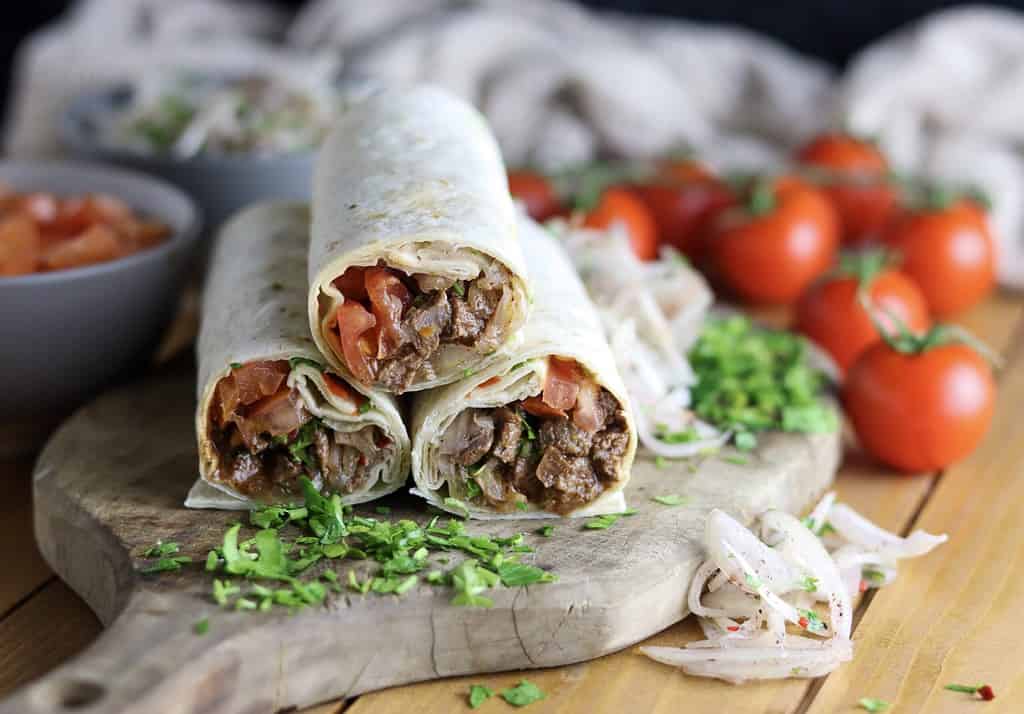
Tantuni FAQ
Tantuni is widely available in Turkey, particularly in the southern regions such as Mersin, Adana, and Antalya. It is typically sold as street food from small food stands and carts. In addition, some restaurants and cafes also offer tantuni on their menus. Outside of Turkey, it may be more difficult to find tantuni, but some Turkish restaurants and food establishments may offer it.
The nutritional value of tantuni can vary, depending on the ingredient used for making the tantuni wraps. Generally, it’s a high-calorie and high-fat food due to the meat and bread used in the wrap. However, it can also be a good source of protein and fiber when fresh vegetables and whole-grain bread are used for the wraps. It is recommendable to feast on tantuni in moderation as part of a balanced diet.
Chicken tantuni is a street food that is getting popular in Turkey and worldwide. Instead of the traditional beef or lamb meat, chicken is stir-fried with the spices like paprika, sumac, black pepper, chili flakes and others. It’s wrapped in lavash bread together with onions, tomatoes and parsley and often served with salad or pickles.
The main difference between tantuni and kebab is the cooking method and presentation. Tantuni is cooked on a griddle and served together with onions and tomatoes wrapped in lavash bread, while kebab is cooked on skewers over an open flame and is usually served in other types of bread with a variety of sides and sauces.
While both dishes involve thinly sliced meat served in thin lavash bread or other flatbread wrap with vegetables and spices, the key difference is in the preparation and added sauces. Tantuni is cooked on a griddle or flat-top grill, while shawarma is cooked on a vertical spit. Additionally, the spices and sauces used in the two dishes can vary depending on the region and preference. Tantuni is often served with a side of pickles and a teaspoon of lemon juice, while shawarma is also served with vegetables and a variety of sauces.
If you don’t have sumac, you can try using a substitute spice or a combination of spices that can provide a similar tangy flavor like Za’atar, fresh lemon juice, lemon zest, vinegar, ground coriander, tamarind and/or lemon pepper seasoning (lemon juice with black pepper).
While sumac is not native to California, some varieties of sumac can grow in the state. The most common variety is the Staghorn sumac (Rhus typhina), which is native to eastern North America but has been introduced to other parts of the continent, including California.
Tasty recipes from the Food nutters
Sataras, the breakfast rock star from the Balkans
Gulasz wolowy, Polish beef goulash
Ričet – the iconic barley soup
INGREDIENTS
- 500 g beef
- 3 medium-sized onions
- 100 g fat or oil
- 3 medium-sized tomatoes
- half bunch of parsley
- sumac
- paprika
- black pepper
- flaked chili
- 5 lavash or tortilla wraps
INSTRUCTIONS
- Peel the onions and cut them into very thin slices. In a bowl, mix them together with sumac and parsley. Cut the tomatoes to small cubes. Cut the beef against the grain into small slices or cubes.
- In a frying pan stir-fry the beef on hot oil or fat. Add the salt and continue cooking on low heat for about 20 minutes, until the beef releases the water and the liquid evaporates and gets absorbed by the beef. Add more water if needed and cook until the beef gets softer and more tender.
- When the water is gone, add two more tablespoons of oil or fat, add the spices, fry for a minute, then add a cup of water and cook slowly on low heat until you get the desired amount of the sauce.
- Cover the beef gravy in the pan with lavash bread or tortilla wrap for a minute to heat it up. When heated, place the wrap on a plate and top it with tomatoes, onion mixture, two or three tablespoons of beef and sprinkle with a little bit more of parsley.Make sure you close at least one side of the wrap to prevent the sauce from leaking.
- Serve warm with additional salad and/or pickles. Enjoy 🙂
NOTES
- When selecting beef for tantuni, it’s best to choose cuts that are more tender and have less connective tissue, as this can result in a chewy texture. It’s also recommended to cut the beef into small cubes or slices, or you can use ground beef as a substitute.
- To ensure the best flavor in your tantuni, it’s important to choose ripe and flavorful tomatoes. Avoid refrigerating them before use, as exposure to low temperatures can affect their taste, aroma, and texture.
- Don’t skip the beef tenderizing process to achieve the perfect bite.
- Don’t be afraid to experiment with different types of meat for your tantuni, such as lamb, chicken, turkey, or goat.
- When assembling the tantuni wrap, make sure to wrap the lavash bread or tortilla wrap as tightly as possible. Close it up at least on one side to prevent any opening or leaking.
Nutrition
If you liked the tantuni recipe, please rate it in the comments below.
Show your love by sharing ❤️



I can’t wait to try this. I have never used sumac before so it will be a new flavor for us which should make our dinner not only delicious but fun! Thank you for sharing this recipe
Indeed, since we tried it the first time we’re using sumac now very often, and it still surprises me how good things taste with it.
I must admit the name caught my eye and I had to check out what you prepared. This does look yummy. Visiting from Sundays on Silverado #135
Thank you Esme, hugs to SA:)
This makes a great snack, and even perfect as a meal for lunch or dinner! Thanks so much for sharing and dropping by Fiesta Friday. Hope to see you soon again!
Thank you Pauline; Fiesta Friday is always a real pleasure.
These look delicious – and something that we would enjoy. Thanks for sharing with #PoCoLo
Thank you Stephanie; I hope you try it and let us know how your tantuni tasted. If you need any help I’ll be happy to assist.
These look fantastic! I will have to try these, I love the ingredients and spices. Thank you for linking up with tell it to me tuesday!